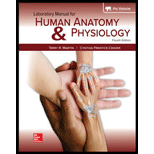
Concept explainers
Which muscle tissue is under conscious control?
- skeletal
- smooth
- cardiac
- stomach
Introduction :
There are three types of muscle tissues namely; skeletal, smooth and cardiac muscles. Muscle tissues are characterized by the presence of elongated cells called muscle fibers, that can contract to create bodily movements.
Answer to Problem 1PL
Correct answer :
The correct answer is option (a) Skeletal.
Explanation of Solution
Explanation/justification for the correct answer :
Option (a) Skeletal. Skeletal muscle cells are long, thread-like, multinucleated and striated with an organized pattern of contractile proteins. These muscles are usually attached to bones and have functions such as body movements, maintaining posture, heat production and providing protection. Skeletal muscles are under conscious control and are considered voluntary. So, the correct answer is option (a).
Explanation for incorrect answer :
Option (b) Smooth. Smooth muscle cells are not striated and are fusiform in shape with the nucleus located to its center. It is located in visceral organs; iris, blood vessels, and respiratory tubes and has functions such as the motion of visceral organs (peristalsis), controlling pupil size and blood flow. Smooth muscle is under involuntary control. So, this is an incorrect option.
Option (c) Cardiac. Cardiac muscle is located only in the heart wall and the cells are branched, striated and have a single nucleus. It is under involuntary control. So, this is an incorrect answer.
Option (d) Stomach. Smooth muscle forms the walls of hollow internal organs. The stomach is made with smooth muscle, which is under involuntary control and functions to pump blood. So, this is an incorrect answer.
Want to see more full solutions like this?
Chapter 10 Solutions
Laboratory Manual For Human Anatomy & Physiology
- Why is it important that skeletal muscle tissues work voluntarily and smooth and cardiac muscle tissues are involuntary?arrow_forwardWhat stimulates Golgi tendon organs? A muscle is contracting with minimal tension. A muscle is stretched nearly to its limit. A muscle has become metabolically active. A muscle starts to relax after strenuous exercise.arrow_forwardWhich of the following muscle types and characteristic is correctly matched? Smooth muscle : Ca-calmodulin regulation of myosin light chain kinase Cardiac muscle : calcium only from the sarcoplasmic reticulum Cardiac muscle : dense body anchoring proteins Skeletal muscle : varicosity at neuromuscular junctionsarrow_forward
- Which of the following muscle types and characteristic is correctly matched? Group of answer choices Cardiac muscle : dense body anchoring proteins Skeletal muscle : varicosity at neuromuscular junctions Smooth muscle : Calcium-calmodulin regulation of myosin light chain kinase Cardiac muscle : calcium only from the sarcoplasmic reticulumarrow_forwardThe type of muscle cell under voluntary control is the ________. a. smooth muscle b. skeletal muscle c. cardiac muscle d. visceral musclearrow_forwardThe smooth muscle tissue is * consists of long muscle fibers Called visceral muscle Its cells have cross striation Its contraction is voluntary 00000 Contact by Desmosomesarrow_forward
- Which type of muscle do you have in your digestive system? A) Cardiac MuscleB) Striated MuscleC) LigamentsD) Smooth Musclearrow_forwardWhat is an example of an involuntary muscle? Biceps Triceps Skeletal muscles surrounding the femur Smooth muscles lining the digestive trackarrow_forwardWhich of the following types of muscle tissues IS correctly associated with an organ in which it would be found? skeletal muscle tissue - in the biceps of the arm cardiac muscle tissue - in the tongue smooth muscle tissue - in the heart skeletal muscle tissue - surrounding the stomach cardiac muscle tissue - surrounding the intestinesarrow_forward
- Differentiate voluntary from involuntary muscle. What is the major difference between epithelial and connective tissues? Choose three organs in your body and list down the tissue/tissues that comprise these organs. Describe its function.arrow_forwardDescribe each in relation to the functions of the muscular system. Excitable or Irritable. Contractible. Extensible. Elasticity. Adaptability.arrow_forwardThe following is NOT a role of muscle tissue: support weight of visceral organs push on bones to initiate movement help maintain body temperature regulate the movement of materials through body openings Which of the following does NOT accurately describe tendons? "Continuous with the epimysium, perimysium, and endomysium" Larger in diameter than muscles. Attach a muscles to bones Cords of fibrous connective tissuearrow_forward
 Human Biology (MindTap Course List)BiologyISBN:9781305112100Author:Cecie Starr, Beverly McMillanPublisher:Cengage Learning
Human Biology (MindTap Course List)BiologyISBN:9781305112100Author:Cecie Starr, Beverly McMillanPublisher:Cengage Learning Medical Terminology for Health Professions, Spira...Health & NutritionISBN:9781305634350Author:Ann Ehrlich, Carol L. Schroeder, Laura Ehrlich, Katrina A. SchroederPublisher:Cengage Learning
Medical Terminology for Health Professions, Spira...Health & NutritionISBN:9781305634350Author:Ann Ehrlich, Carol L. Schroeder, Laura Ehrlich, Katrina A. SchroederPublisher:Cengage Learning- Lifetime Physical Fitness & WellnessHealth & NutritionISBN:9781337677509Author:HOEGERPublisher:Cengage
 Biology: The Dynamic Science (MindTap Course List)BiologyISBN:9781305389892Author:Peter J. Russell, Paul E. Hertz, Beverly McMillanPublisher:Cengage Learning
Biology: The Dynamic Science (MindTap Course List)BiologyISBN:9781305389892Author:Peter J. Russell, Paul E. Hertz, Beverly McMillanPublisher:Cengage Learning





